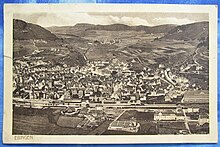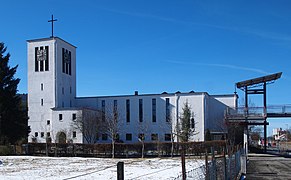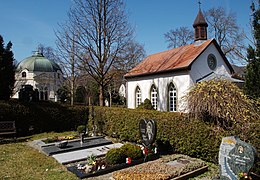Ebingen
This article needs additional citations for verification. (August 2008) |


Ebingen is a town in the large district of Albstadt, district Zollernalbkreis, in the German state of Baden-Württemberg. It is located on the river Schmiecha, a left-hand tributary of the Danube, south of Tübingen and west of Ulm.
History[]
Ebingen received city rights around 1250 from the Hohenberg ducal family. In 1367 it became a part of the kingdom of Württemberg. In the early 20th century, it was known for manufacturing velvet and (Manchester) goods, stockings, stays, hats, needles, tools and tanneries.[1] In 1975 Ebingen joined 8 other towns in the area to form the city of Albstadt. Current population is at 18,700, with all of Albstadt having around 45,000 inhabitants.
Economy[]
Most of the textiles industry is gone today, leaving some monuments, like Villa Haux. However, one of the world's biggest makers of industrial needles, Groz-Beckert still resides there. Other prominent local companies include Mey (knitwear), Mettler Toledo (weighing systems) and a major part of Assa Abloy security systems (Eff-Eff Brand). Ebingen also hosts the technical and computer science faculties of with about 3,000 students (2014).

Architecture[]

Citizens' tower, ~1500

old warehouses

Former velvet factory

Haux houses

Central square: Schweinweiher, Kurt-Georg-Kiesinger-Platz, Marktstraße

Art nouveau Town hall by Martin Elsaesser
Churches[]
- The main church of Ebingen is St.Martin's church. The choir is late gothic (1473), the tower from 1670. They are integrated in the art nouveau building from 1906.
- Next to the church is the former hermitage, inhabited from 1344 until 1608 by third order nuns.
- The smaller Kapellkirche was founded in 1382 „in honor of Our Lady and of the Holy Sepulchre in Jerusalem“. The existing building is from 1490, renewed in 1833.
- Since the reformation, Ebingen was Protestant. A new Catholic church was not built before 1892 for workers of the then growing industry. St. Joseph church needed to be enlarged in 1912.
- The evangelic Friedenskirche (peace church) was built in 1931 in New Objectivity style at the outskirt of the town. Urban development let it end up in a commercial area.
- After World War II, four modern churches were built, for both denominations in new residential areas in the west and east.

Martinskirche, main façade

hermitage

St. Joseph

Friedenskirche

Heilig-Kreuz (holy cross)

Thomas church

new and old cemetery chapel

BGG Lighthouse (Pentecostal)
Notable people[]
- Kurt Georg Kiesinger (1904-1988), German politician, German former chancellor
References[]
- ^ . Encyclopædia Britannica. 8 (11th ed.). 1911. p. 842.
- Towns in Baden-Württemberg
- Albstadt














